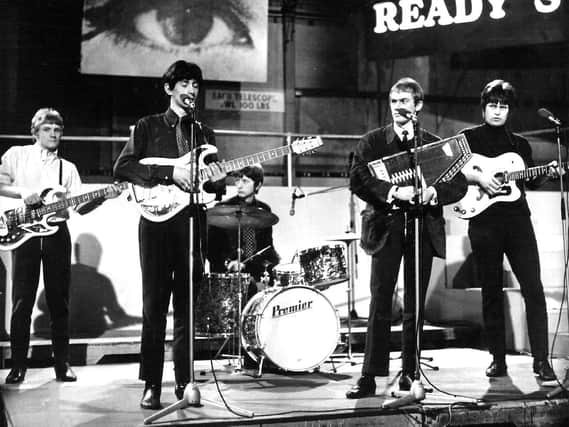How the shooting of Reg Calvert ended Rugby's spell in the 1960s rock and roll spotlight


It was a typically hot June morning back in 1966 when the news broke.
The reporters’ room at the Rugby Advertiser in those days was, at the best of times, a stuffy, cigarette smoke-filled afterthought at the back of the Albert Street building.
Advertisement
Hide AdAdvertisement
Hide AdAnd with all the windows facing east, it never took all that long for temperatures to rise during the summer months.
But this was an item of news that raised the thermometer’s mercury even further…
Chief reporter Len Archer’s phone rang once. Then twice. But that’s all it was allowed, for Len, a permanently hyperactive individual, had seized the Bakelite device in an instant and barked: “Archer – chief reporter!”
And grabbing his notebook with his free hand, he was scribbling away like mad in his perfect shorthand note.
Advertisement
Hide AdAdvertisement
Hide AdIt soon became apparent that this was a major news story breaking.
After what seemed like an age, Len replaced the receiver, stared into space for a moment, and then said, in muted tones: “Bl**dy hell. Reg Calvert’s been shot and killed.”
Down the years, there has been a lot of speculation about the bizarre set of circumstances surrounding Calvert’s death. Much has been written about the man who, at one time, had been tipped to be Rugby’s equivalent to Beatles svengali Brian Epstein.
At this point, I must stress that there is not room in this article to write a history of Reg Calvert, or speculate on the manner of his death. Suffice to say that he was a truly amazing figure, a total one-off, and most definitely a legend in his relatively short lifetime.
Advertisement
Hide AdAdvertisement
Hide AdThe shock waves spread far and wide. Calvert had operated a ‘pop school’ at Clifton Hall, near Rugby, having earlier run a ‘Beat academy’ in Southampton with his wife Dorothy.
At Clifton Hall, he set up a ‘stable’ of local rock groups, an enterprise that was run in tandem with his pirate radio interests.
Calvert’s first taste of success came when he launched The Fortunes in 1963, the group eventually scoring a huge success with You’ve Got Your Troubles a couple of years later in the summer of 1965.
Reg Calvert had arrived – and was soon looking around for another group that could repeat the success of The Fortunes.
Advertisement
Hide AdAdvertisement
Hide AdThis turned out to be local outfit The Liberators, who had that summer enjoyed a degree of success with It Hurts So Much/You Look So Fine, a couple of songs written by guitarist Tony Newman.
Rapidly renamed Pinkerton’s Assorted Colours, with new recruit Samuel ‘Pinkerton’ Kempe on vocals, they would soon shoot up the charts with another Newman song titled Mirror, Mirror.
Down the years, I must have written reams about fellow Churchover lad Tony Newman, in various articles and also referred to him in my books Beef Cubes and Burdock and Go and Make the Tea, Boy!
But the biggest mystery, apart from the unanswered questions regarding Calvert’s death, is this – why on earth didn’t this supremely gifted songwriter end up there with the likes of Jagger, Richards, Lennon and McCartney?
Advertisement
Hide AdAdvertisement
Hide AdThere is no doubt in my mind that Calvert’s death did indeed stall the Pinkertons’ progress, but it’s not the full picture, in my view.
For I think that the moment Calvert died, Rugby abruptly dropped off the national rock and pop ‘map’. This twist of fate came at a crucial time when the town was just beginning to be nationally known for the quality of its groups and musicians.
And the fact remains that Tony Newman did indeed write a string of very impressive songs. Don’t Stop Loving Me Baby, Magic Rocking Horse, The Lies in Your Eyes and Me Without You were well-crafted numbers that – even though written in the mid to late 1960s – have nevertheless travelled reasonably well up to the present day.
In particular, Duke’s Jetty – which immortalised the short thoroughfare between Rugby’s High Street and Sheep Street – will always be a favourite of mine.
Advertisement
Hide AdAdvertisement
Hide AdThis tune was, of course, a group collaboration, created by Tom Long, Stu Colman, Sam Kempe, Dave Holland and Tony Newman.
Pinkerton’s Assorted Colours saw various changes of personnel, eventually becoming The Flying Machine, destined to enjoy great success in America with Smile a Little Smile for Me, sadly not to be repeated in Britain, where although it had plenty of airplay, it failed to notch up impressive sales.
This article is only the briefest outline of one of Rugby’s greatest stories, one that was being written at a time when young people – for the first time in history - were finding their voices in a
Britain that was still recovering from the effects of the 20th century’s global wars.
Advertisement
Hide AdAdvertisement
Hide AdOnce again, I must stress that this article expresses a purely personal view. My only regret is that someone of the stature of Tony Newman didn’t rise even further in the rock firmament… and rightfully take his place among the rising stars of that momentous time when merit could – and so often did - receive its rightful recognition and rewards.
John Phillpott was a reporter on the Rugby Advertiser from 1965 to 1969 and is a published author.